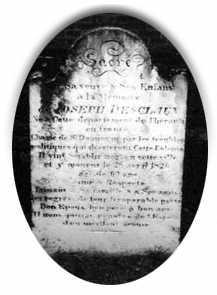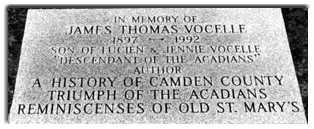 |
|
The Acadians of St. Marys In the 17th century, the Acadians settled in the French provinces of Nova Scotia, New Brunswick, and Prince Edward Island. Many of the original settlers were from the La Chausée, Poitou; Aunis; Angoumois; and Saintonge areas of France. Acadians were known as hard workers. They lived in extended families and were generally non-materialistic. Their population in the New World grew steadily for many years. In 1710, France lost Acadia and the English took over the rule of the lands. For the next 45 years, the Acadians lived relatively peacefully under English rule. In 1755, the English began what was to be known as Le Grand Dérangement or The Great Disturbance. Thousands of Acadians were forced to flee the area. Over 6,000 fled by boat while thousands of others fled on foot. One of the main reasons for their expulsion was the English government's desire to take over the rich lands of Acadia. One of the other reasons was their Catholic faith - and their refusal to abandon it. Some sources claim that 20%-50% of the Acadian population died during this time. The main causes of death include starvation, exposure, and disease. The Acadians were refused refuge by every colony, including Georgia*, except Maryland. Reasons for the state's turning their backs on these refugees may range from religious differences, the colonies being heavily Protestant (except for Catholic-heavy Maryland), to an unwillingness to get in the middle of an French-English feud. *Some local accounts state that it was the Acadian's own need to travel that caused them to not settle in Georgia. My own research does not support this idea as Acadians were generally thought to be very stable people who would have happily settled in any land that would support them. During this time, apparently in an attempt to blend-in, some Acadians changed their names. LeBlanc became Whites, Bruns became Browns. The French government decided to build a colony on the island of Saint Domingue or Santa Domingo. The wandering Acadians were sent for and eventually some made it to the island. Here they were promised adequate food, housing, and work. Instead they were starved, mistreated, and forced to work for the Crown building a Naval Port. In fact, it is estimated that approximately 20% died while en-route, via ship, to Santa Domingo. Their bodies were dumped at sea without ceremony. By 1765, some Acadians were asking to leave. Some Acadians actually made it out legally. Others fled by any means possible. In the 1790s the native Haitian people revolted against the French. Mistreated, malnourished, and landless, the Acadians that were able fled to other areas, including the southeastern United States. This time, Georgia welcomed them into the state. While most Acadians moved on to other parts of the country, such as Louisiana, a few settled in St. Marys, Camden County, Georgia.
Sacre aime & Respecte
Margurite Comeau, who died in 2/1/1829 and is buried in St. Marys Oak Grove Cemetery, is the only settler who was actually born in Acadia. The others, her descendents, were born either in France, Santa Domingo, or in Georgia. She married Joseph Desclaux (1757-4/28/1826). Joseph was born in Therault, France. He was in Santa Domingo and fled with other Acadians. Their daughter, Francoise Angelique Desclaux (1/12/1804-6/3/1864) married Jacques Vocelle on 11/26/1829. Jacques, who was also born in Santa Domingo, died on 11/18/1869 at 82 years of age. All are buried in St. Marys Oak Grove Cemetery. James T. Vocelle, who wrote the first History of Camden County book, is descended from these Acadians.
The Acadians and their descendents found peace, acceptance, and a secure life in Old St. Marys. Here they lived, worshiped their Catholic religion, married, and died. Many are buried in the old Oak Grove Cemetery in downtown St. Marys. Some of their gravestones, which lie behind high brick walls, are in French but are understandable even to those untrained in the French language. Several local families married Comeau descendents. Many of the surnames of descendents are recognized as local: Vocelle, Desclaux, DuBois (DuBose), DuFour, Arnow (Arnau), Bachlott, Flood, Baratte, Fox, and others.
|
 The headstone of
Joseph Desclaux
is in French, can anyone provide a good translation? I have the basic gist
of it, but would like a translation that's as accurate as possible. I
understand that basically it says "Sacred to the memory of (our son? our
brother?) Joseph Desclaux of Therault, France. Fled the (political?)
troubles of St. Domingne (Santo Domingo). Died April 28, 1826 at 69 years
of age. I'm not sure about the second half except that it says something
about the family and friends of Desclaux.
The headstone of
Joseph Desclaux
is in French, can anyone provide a good translation? I have the basic gist
of it, but would like a translation that's as accurate as possible. I
understand that basically it says "Sacred to the memory of (our son? our
brother?) Joseph Desclaux of Therault, France. Fled the (political?)
troubles of St. Domingne (Santo Domingo). Died April 28, 1826 at 69 years
of age. I'm not sure about the second half except that it says something
about the family and friends of Desclaux. James T. Vocelle, a descendent of the Acadians, was born in 1897 in Camden County, Georgia. He wrote a book on local history, A History of Camden County, as well as the books Triumph of the Acadians and Reminiscences of Old St. Marys.
James T. Vocelle, a descendent of the Acadians, was born in 1897 in Camden County, Georgia. He wrote a book on local history, A History of Camden County, as well as the books Triumph of the Acadians and Reminiscences of Old St. Marys.